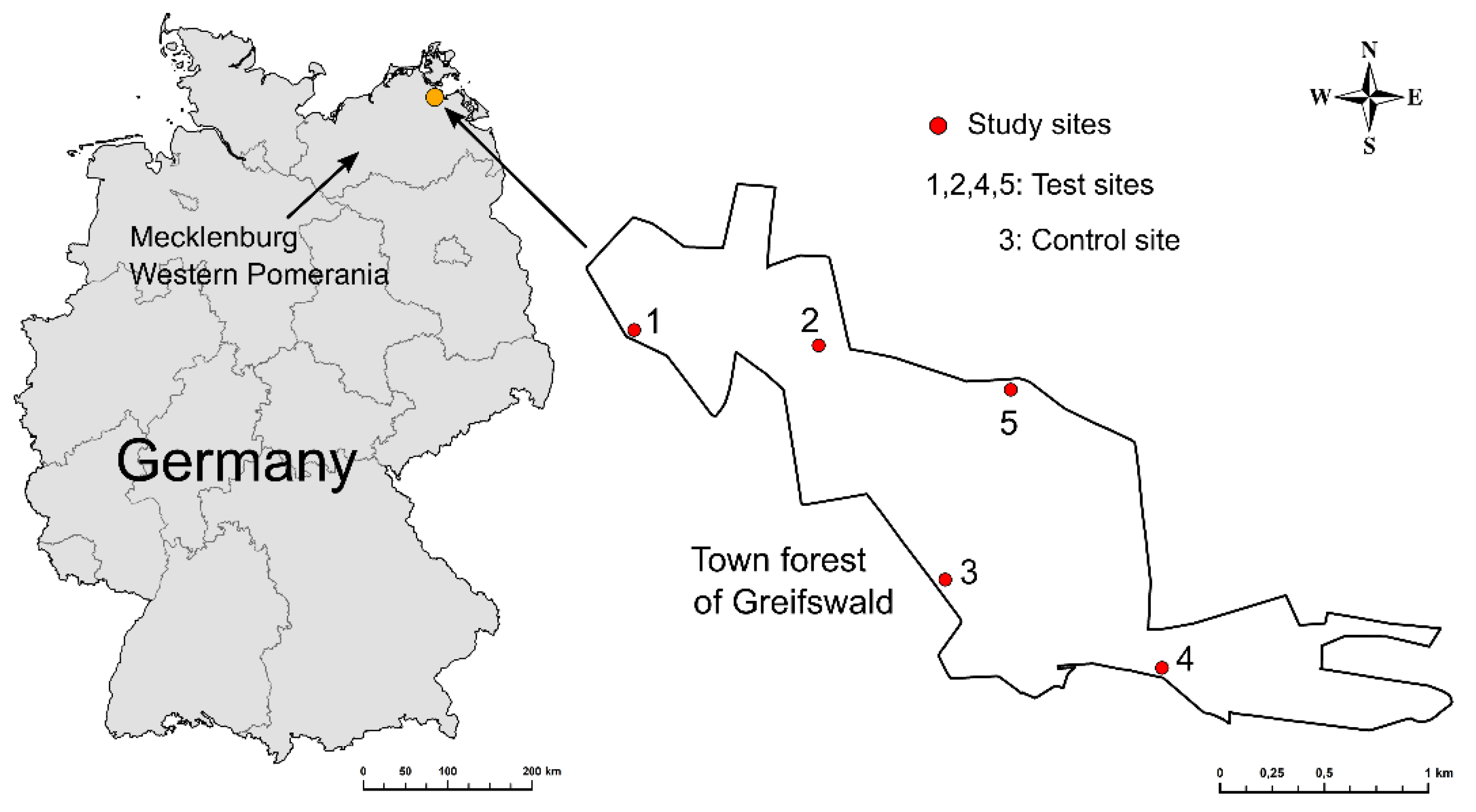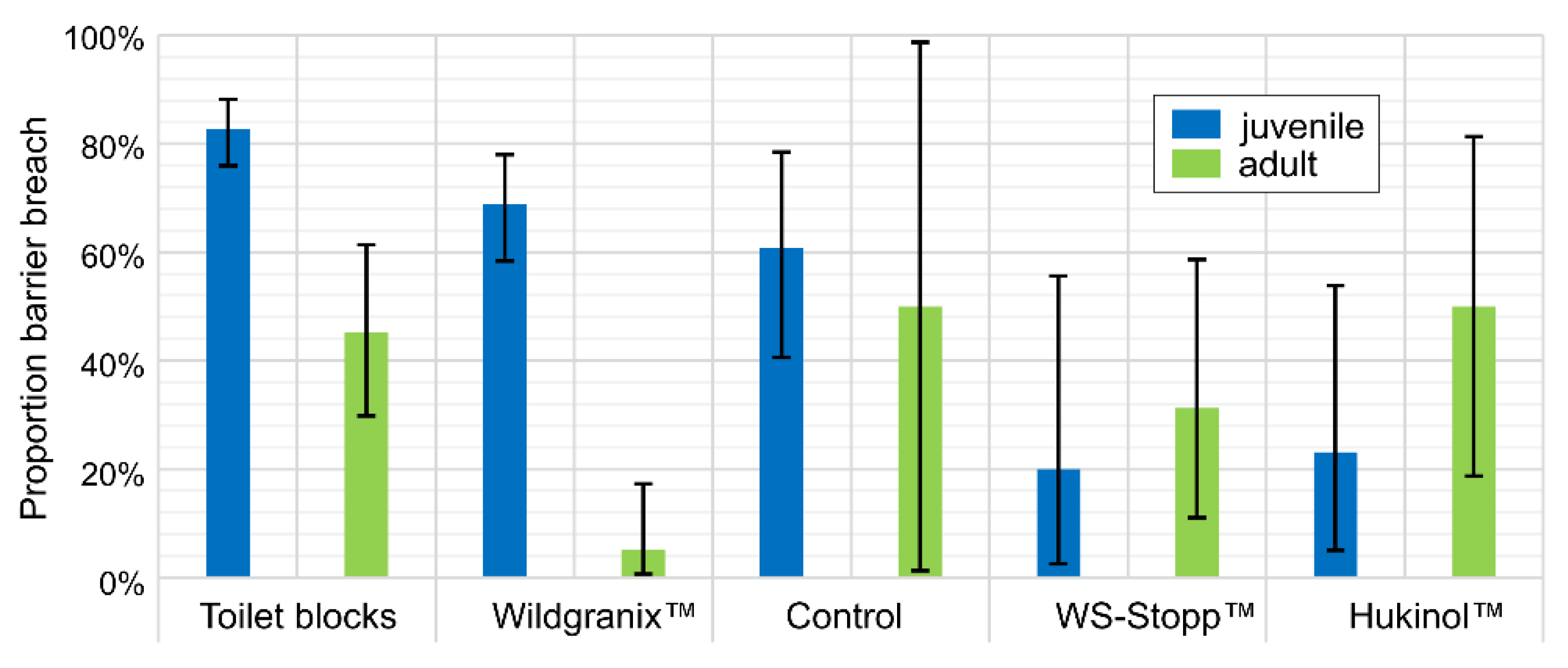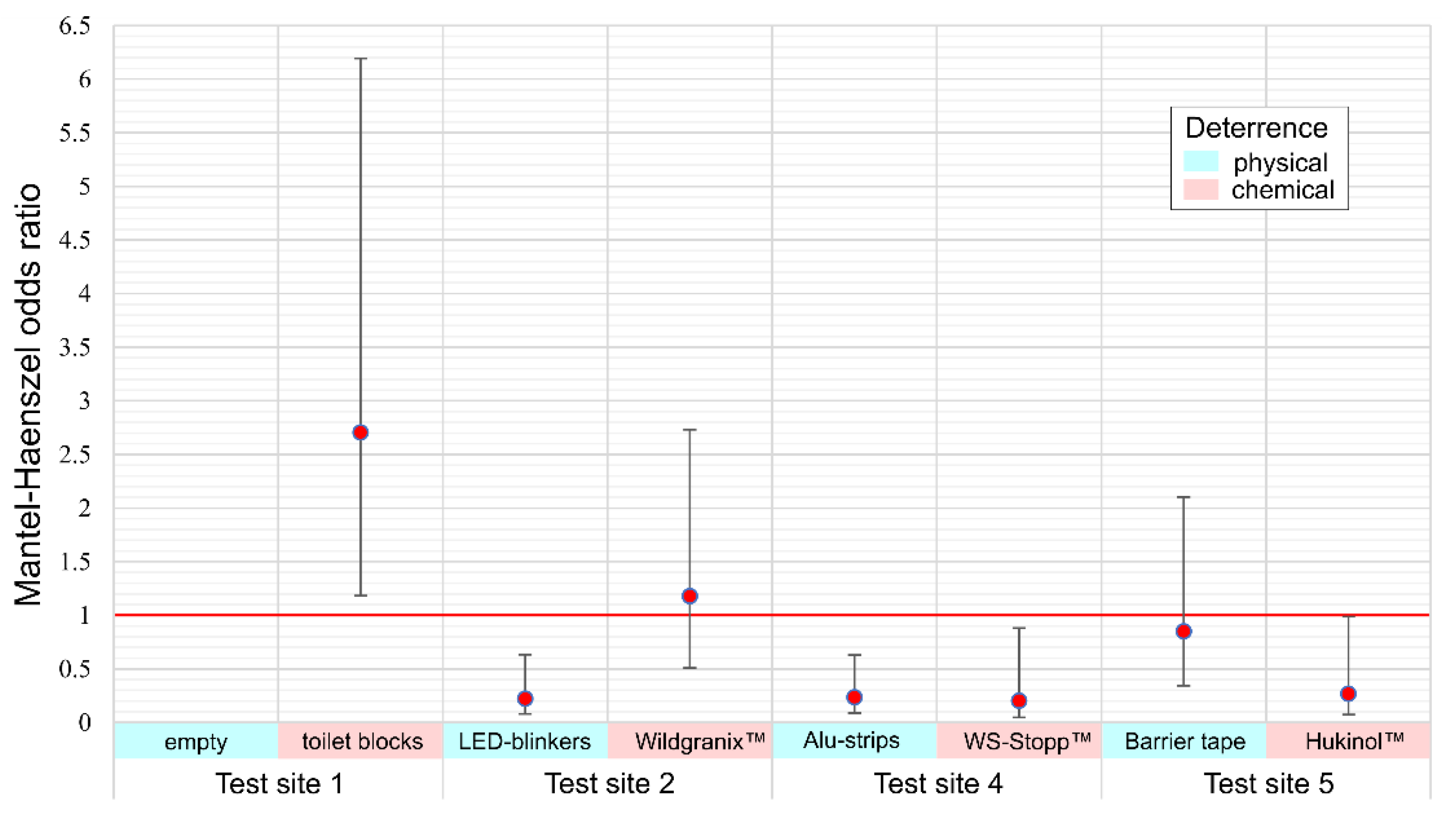Testing Different Deterrents as Candidates for Short-Term Reduction in Wild Boar Contacts—A Pilot Study
Abstract
Simple Summary
Abstract
1. Introduction
2. Materials and Methods
2.1. Study Area and Sites
2.2. Camera System
2.3. Deterrent Systems
2.3.1. Physical Deterrents
2.3.1.1. Aluminum Strips
2.3.1.2. LED Blinkers
2.3.1.3. Barrier Tape
2.3.2. Chemical Deterrents
Toilet Blocks
Wildgranix™
Wildschwein-Stopp™
Hukinol™
2.4. Study Design
2.5. Data Management and Analysis
3. Results
3.1. General Findings
3.2. Effect of Deterrents
3.2.1. Effect of Physical Deterrents
3.2.2. Effect of Chemical Deterrents
3.2.3. Effect of Deterrents Combined for Age Classes
4. Discussion
5. Conclusions
Author Contributions
Funding
Acknowledgments
Conflicts of Interest
References
- Probst, C.; Gethmann, J.; Amler, S.; Globig, A.; Conraths, F.J.; Knoll, B. The potential role of scavengers in spreading African swine fever among wild boar. Sci. Rep. 2019, 9. [Google Scholar] [CrossRef] [PubMed]
- Anonymous. Technical Fact Sheet African Swine Fever. Center for Food Security and Public Health 2015. Available online: http://www.cfsph.iastate.edu/Factsheets/pdfs/african_swine_fever.pdf (accessed on 18 November 2020).
- Sanchez-Vizcaino, J.M.; Martinez-Lopez, B.; Martinez-Aviles, M.; Martins, C.; Boinas, F.; Vial, L.; Michaud, V.; Jori, F.; Etter, E.; Albina, E.; et al. Scientific reviews on classical swine fever (CSF), African swine fever (ASF) and African horse sickness (AHS), and evaluation of the distribution of arthropod vectors and their potential for transmitting exotic or emerging vector-borne animal diseases and zoonoses. EFSA Sci. Opin. 2009. Available online: https://efsa.onlinelibrary.wiley.com/doi/pdf/10.2903/sp.efsa.2009.EN-5 (accessed on 18 November 2020).
- EFSA. African Swine fever. EFSA J. 2015, 13, 4163. [Google Scholar]
- Anonymous. Disease Control Strategy for African and Classical Swine Fever in Great Britain; DEFRA: London, UK, 2014. [Google Scholar]
- Guinat, C.; Andrey Gogin, A.; Blome, S.; Keil, G.; Pollin, R.; Pfeiffer, D.U.; Dixon, L. Transmission routes of African swine fever virus to domestic pigs: Current knowledge and future research directions. Vet. Rec. 2016, 178, 262–267. [Google Scholar] [CrossRef] [PubMed]
- EFSA. Scientific opinion on African swine fever—EFSA Panel on Animal Health and Welfare (AHAW). EFSA J. 2010, 8, 1556. [Google Scholar]
- Probst, C.; Globig, A.; Conraths, F.J.; Depner, K.; Knoll, B. Behaviour of free ranging wild boar towards their dead fellows: Potential implications for the transmission of African swine fever. R. Soc. Open Sci. 2017, 4. [Google Scholar] [CrossRef] [PubMed]
- Chenais, E.; Ståhl, K.; Guberti, V.; Depner, K. Identification of Wild Boar–Habitat Epidemiologic Cycle in African Swine Fever Epizootic. Emerg. Infect. Dis. 2018. [Google Scholar] [CrossRef] [PubMed]
- Wildgame Innovations. QUICK-SET™ 270. Available online: https://www.wildgameinnovations.com/quick-set-270 (accessed on 27 August 2020).
- Anton Seissiger GmbH. 97080 Würzburg, +49931-41797980. Available online: https://www.seissiger-wildkamera.eu/ (accessed on 27 August 2020).
- Warnband Böttcher AG. Available online: https://www.bueromarkt-ag.de/warnband_boettcher-ag_absperrband,p-115.html (accessed on 27 August 2020).
- Hagopur GmbH. 86899 Landsberg/Lech, +498192-72999-62. Available online: https://www.hagopur-shop.de/hagopur-set---wildschwein-stopp (accessed on 27 August 2020).
- Isotronic. Available online: https://www.amazon.de/ISOTRONIC-Wildschweinabwehr-Wolfsvergr%C3%A4mer-Waschb%C3%A4r-Schreck-Tiervertreiber/dp/B07FF5787W?th=1 (accessed on 27 August 2020).
- Henkel AG & Co. KGaA. 40589 Düsseldorf, +49211-7970. Available online: https://www.wc-frisch.de/de/startseite/produkte/wc-frisch-kraft-aktiv/wc-frisch-kraft-aktiv-lemon.html (accessed on 27 August 2020).
- SeNaPro GmbH. 91224 Pommelsbrunn/Hartmannshof, +499154-49100. Available online: www.senapro.de (accessed on 27 August 2020).
- Kieferle GmbH. 78244 Gottmadingen/Randegg, +497734-97203. Available online: www.kieferle.com (accessed on 27 August 2020).
- Grube KG Forstgerätestelle. Available online: https://www.grube.de/media/pdf/c7/3b/94/75-523_Wildgranix_EN.pdf (accessed on 27 August 2020).
- Grube KG Forstgerätestelle. Available online: https://www.grube.de/media/pdf/ea/94/26/SD_75-501.pdf (accessed on 27 August 2020).
- Grube KG Forstgerätestelle. Available online: https://www.grube.de/media/pdf/68/e5/b1/SD_Hukinol.pdf (accessed on 27 August 2020).
- Kluth, G.; Blum, C.; Reingardt, I.; Huckschlag, D.; Stier, N.; Schollerer, A.; Rahm, L. FFM 2.0—Software zur Beschreibung und Archivierung von Fotofallenbildern; Licenced for TU: Dresden, Germany, 2011. [Google Scholar]
- Garrett, G.; Hadley, W. Dates and Times Made Easy with lubridate. J. Stat. Softw. 2011, 40. [Google Scholar] [CrossRef]
- R-DEVELOPMENT-CORE-TEAM. R: A Language and Environment for Statistical Computing; R Foundation for Statistical Computing: Vienna, Austria, 2020. [Google Scholar]
- Brown, L.D.; Cai, T.T.; DasGupta, A. Interval Estimation for a Binomial Proportion. Stat. Sci. 2001, 16, 101. [Google Scholar]
- Dorai-Raj, S. Binom: Binomial Confidence Intervals For Several Parameterizations. 2014. Available online: https://cran.r-project.org/web/packages/binom/binom.pdf (accessed on 18 November 2020).
- Dohoo, I.R.; Martin, W.; Stryhn, H. Veterinary Epidemiologic Research; University of Prince Edward Island: Charlottetown, PE, Canada, 2003. [Google Scholar]
- Thrusfield, M.V. Veterinary Epidemiology, 3rd ed.; Blackwell Science: Hoboken, NJ, USA, 2005. [Google Scholar]
- Nakazawa, M. FMSB: Functions for Medical Statistics Book with some Demographic Data. 2019. Available online: https://cran.r-project.org/web/packages/fmsb/fmsb.pdf (accessed on 18 November 2020).
- Schlageter, A.; Haag-Wackernagel, D. Evaluation of an odor repellent for protecting crops from wild boar damage. J. Pest Sci. 2012, 85, 209. [Google Scholar] [CrossRef]
- Schlageter, A.; Haag-Wackernagel, D. Effectiveness of solar blinkers as a means of crop protection from wild boar damage. Crop Prot. 2011, 30, 1216–1222. [Google Scholar] [CrossRef]
- Eguchi, Y.; Tanida, H.; Tanaka, T.; Yoshimoto, T. Color discrimination in wild boars. J. Ethol. 1997, 15, 1. [Google Scholar] [CrossRef]
- Erbinger, M. Schwarzwildvergrämung—Uns stinkt’s. Pirsch 2012, 5, 44–51. [Google Scholar]





| Week | ||||
|---|---|---|---|---|
| Study Site | 1–15 1 | 16–19 2 | 20–23 1 | 24–27 2 |
| 3-Control | Initial luring | --- | “Wash-out” | --- |
| 1-Test | Initial luring | --- | “Wash-out” | Toilet blocks |
| 2-Test | Initial luring | LED blinkers | “Wash-out” | Wildgranix™ |
| 4-Test | Initial luring | Alu strips | “Wash-out” | WS-Stopp™ |
| 5-Test | Initial luring | Barrier tape | “Wash-out” | Hukinol™ |
| Week/Deterrent/Count | ||
|---|---|---|
| Study Site | 16–19 | 24–27 |
| 3-Control | ---1 (20/0) 2 | --- (10/2) |
| 1-Test | --- (not recorded) | Toilet blocks (162/42) |
| 2-Test | LED blinkers (30/85) | Wildgranix™ (93/39) |
| 4-Test | Alu strips (38/55) | WS-Stopp™ (10/16) |
| 5-Test | Barrier tape (51/7) | Hukinol™ (13/10) |
Publisher’s Note: MDPI stays neutral with regard to jurisdictional claims in published maps and institutional affiliations. |
© 2020 by the authors. Licensee MDPI, Basel, Switzerland. This article is an open access article distributed under the terms and conditions of the Creative Commons Attribution (CC BY) license (http://creativecommons.org/licenses/by/4.0/).
Share and Cite
Denzin, N.; Helmstädt, F.; Probst, C.; Conraths, F.J. Testing Different Deterrents as Candidates for Short-Term Reduction in Wild Boar Contacts—A Pilot Study. Animals 2020, 10, 2156. https://doi.org/10.3390/ani10112156
Denzin N, Helmstädt F, Probst C, Conraths FJ. Testing Different Deterrents as Candidates for Short-Term Reduction in Wild Boar Contacts—A Pilot Study. Animals. 2020; 10(11):2156. https://doi.org/10.3390/ani10112156
Chicago/Turabian StyleDenzin, Nicolai, Frithjof Helmstädt, Carolina Probst, and Franz J. Conraths. 2020. "Testing Different Deterrents as Candidates for Short-Term Reduction in Wild Boar Contacts—A Pilot Study" Animals 10, no. 11: 2156. https://doi.org/10.3390/ani10112156
APA StyleDenzin, N., Helmstädt, F., Probst, C., & Conraths, F. J. (2020). Testing Different Deterrents as Candidates for Short-Term Reduction in Wild Boar Contacts—A Pilot Study. Animals, 10(11), 2156. https://doi.org/10.3390/ani10112156





